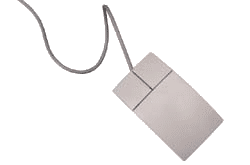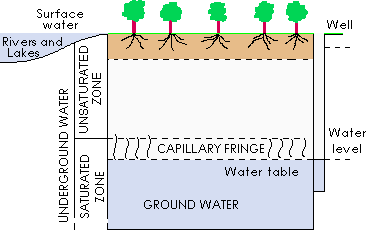

| Instructions on Use | |
| Program Overview | |
| Purpose of Program | |
|
FAQs (frequently asked questions) About Ground Water |
![]() Return to the Table of Contents
Return to the Table of Contents
Some images contain one link, others contain many
links.  You can tell if an image contains links
because your cursor will change from an arrow to
a hand.
If there is only a single link, as is typical of navigational icons that return you to the previous screen or to the top of the current file, the image is displayed
with a red (blue) border. Imagemaps, i.e. images that have several "hot spots" or
links defined within their boundaries, are indicated as such by the text directions
preceding the image and are activated by clicking the mouse on the portion
of the map of interest. For example, on the EPA Regional Contact Map, a person could
learn the mailing address of USEPA Region 5 by clicking on state of Illinois.
You can tell if an image contains links
because your cursor will change from an arrow to
a hand.
If there is only a single link, as is typical of navigational icons that return you to the previous screen or to the top of the current file, the image is displayed
with a red (blue) border. Imagemaps, i.e. images that have several "hot spots" or
links defined within their boundaries, are indicated as such by the text directions
preceding the image and are activated by clicking the mouse on the portion
of the map of interest. For example, on the EPA Regional Contact Map, a person could
learn the mailing address of USEPA Region 5 by clicking on state of Illinois.
Explore as much or as little of the program as is of interest to you. You can quickly reach the sections of interest by using the menus provided. The title box on your browser indicates the name of the section you are currently viewing. The "Location" (in Netscape) or path listing also provides a visual clue as to your position in the program.
PROGRAM OVERVIEW
Ground water is an important resource in the United States. It replenishes our streams, rivers, habitat. Ground water is also an important and bountiful source of fresh water for irrigation, industry, and communities. 75% of our cities depend on ground water for part or all of their drinking water supplies.
For 50% of all Americans (including 95% of the rural population), ground water is the primary source of drinking water. Despite this dependence, ground water is not well understood by the majority of people.
 This computer program presents the following:
This computer program presents the following:
Water quality issues considered are: "where do water contaminants come from?", "what treatment devices should be used for specific contaminants?", and "how can we modify our actions to preserve and improve ground water quality?".
PURPOSE STATEMENT
This program is written for community leaders, public water system suppliers
and the general public that has an interest in protecting both their water supply and ground water
in general.
 Community leaders will find special interest in the sections about communities in
the What You Can Do section and the listing of the programs already in place in the
Federal, State and Local Ground Water Protection Programs section.
Community leaders will find special interest in the sections about communities in
the What You Can Do section and the listing of the programs already in place in the
Federal, State and Local Ground Water Protection Programs section.
The listing of all of the USEPA regulated contaminants and monitoring requirements in the Ground Water Quality - Contamination Menu section may be helpful to public water system suppliers.
The general public can easily understand the concepts introduced in this program, become educated about factors that can affect their own water supply, and then apply this knowledge in actions to protect and conserve one of the most important natural resources.
| © Copyright |